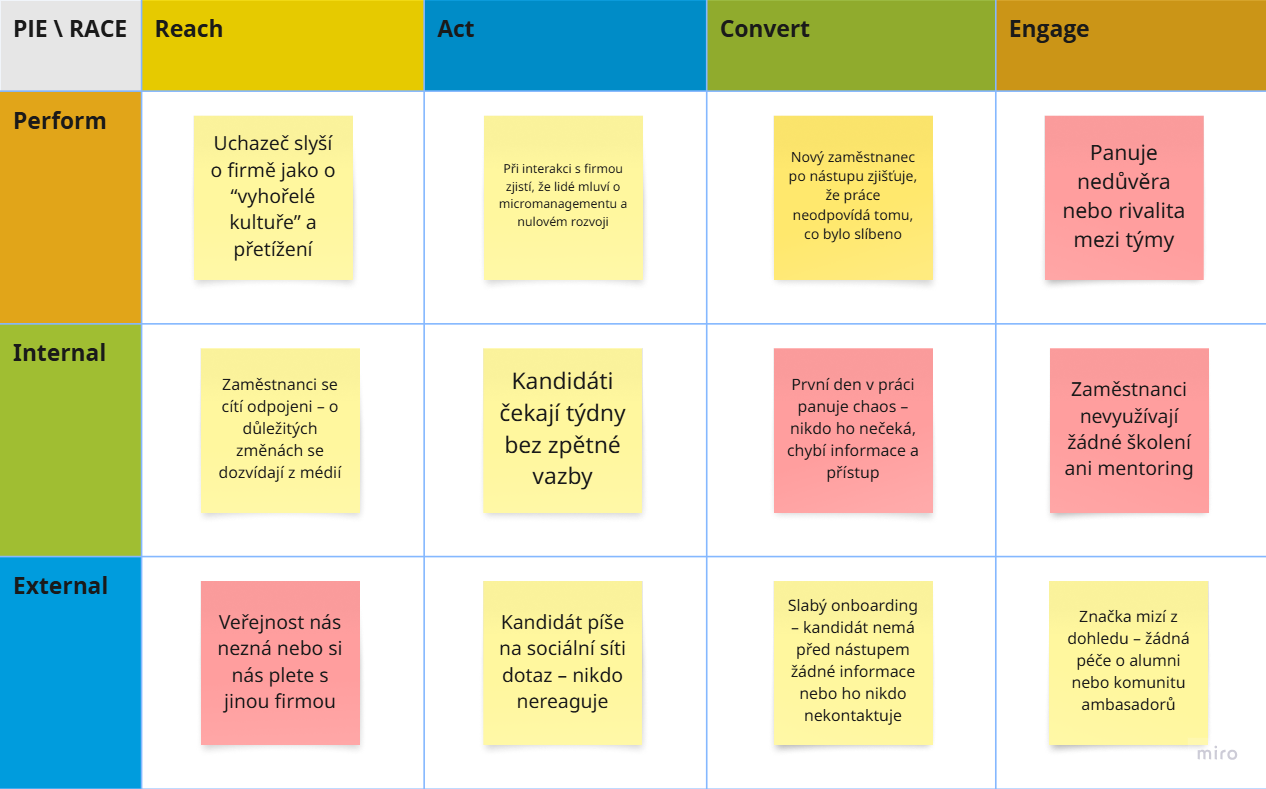How many times have you evaluated your employer brand based on gut feelings? What if there was a more reliable way? HR professionals today face a number of challenges, from talent shortages to employee engagement to fierce competition in the job market. Intuition alone is not enough. Quality decisions require data. A strategic, data-driven approach to employer branding helps to clearly determine where to focus energy, time, and money. Employer branding data is increasingly important.
Hero image by fauxels @ Pexels
The importance of data in HR is growing in proportion to the pressure for efficiency and measurable results. Companies that rely on data have a significant competitive advantage – they are able to quickly respond to changes in the labor market and adapt their employer branding strategy according to the real needs and preferences of candidates and employees.
Why Employer Branding Without Data Is Like a Car Without Navigation
Employer branding is no longer just about feelings or subjective opinions, but above all about strategic management. If you want to manage your employer brand effectively, it is essential to start working with data.
Subjective impressions can be misleading, but data will help you reveal the reality of employees and applicants as it really is. Thanks to this, you can better target your activities, make strategic decisions and optimize the overall impression that your company creates.
Imagine driving a car without navigation – you may hit the target, but you will probably get lost several times. Data serves as a reliable navigation and shows you the real situation and the direction of the next journey.
Without data, employer branding is often based on assumptions and subjective opinions. This leads to bad decisions and unnecessary spending. Working with data means accuracy, efficiency and certainty in decision-making.
From Feelings to Evidence: What Data to Use in Employer Branding?
Data from your employees and candidates is a source of valuable information. These include, for example, digital footprints on a career website, results of employee satisfaction surveys, or feedback from candidates after selection procedures.
The data obtained in this way can reveal weak points in the recruitment process, employee dissatisfaction with specific aspects of the work environment, or, conversely, opportunities to improve the company culture.
Strategic decisions such as adjustments to the EVP or investments in specific benefits should be based on this data.
A lot of important data is often missed by people in HR, even though it is at their fingertips.
Let’s give a few examples:
- Employee surveys (satisfaction, engagement)
- Candidate Experience data (applicant satisfaction, recruitment time)
- Data from HR systems (fluctuation, engagement level)
- External digital data (social listening, sentiment online)
Tip: Do you have access to this data and are you using it effectively?
Often, all you need to do is capture the data correctly. Analyze it regularly and systematically. This will give you valuable insights into the real situation and the ability to intervene quickly where it is most needed.
Through data, we can monitor how well we are connecting our promise (branding) with the real experience of candidates and employees (experience). In other words, whether what we say as a brand actually corresponds to what people experience when they come into contact with us. Data helps measure and manage this difference.
How Data Can Help You Improve Your Employer Brand
If your brand’s promises are at odds with your employees’ actual experiences, there’s a credibility issue. Data from engagement surveys or internal questionnaires can show how close the gap is, or where the biggest gaps are.
For example, a high turnover rate in the first six months of employment may indicate that the actual experience of new hires is not meeting the expectations you created for them during the hiring process.
Here are a few examples of areas where data can be used to improve your brand.
Improving Candidate Experience
-
Essence: Improving the impression and satisfaction of candidates during the hiring process
-
Metrics: Candidate NPS, response speed, candidate ratings
Focus on the quality of the candidate experience during the hiring process. A negative experience spreads quickly, while a positive one can attract more talent. Monitor how quickly you respond, what impression candidates have, and where the process is unnecessarily stalling.
Realistic EVP: What We Promise vs. What We Actually Deliver
-
Essence: Verifying whether the company delivers on its promises regarding benefits and working conditions.
-
Metrics: Satisfaction with benefits, use of benefits, understanding of EVP by employees
Many companies promise flexibility, development, or a great atmosphere. But what is the reality? You can use data to verify whether your people perceive the values and benefits in the same way that you communicate them externally.
Internal Communication and Culture: Data Instead of Assumptions
-
Essence: Effectively using data to strengthen internal communication and company culture.
-
Metrics: eNPS, internal communication sentiment, internal surveys
Employees need to believe that their voice counts. Regularly collecting data on the mood of the team or the effectiveness of communication will help you prevent frustration and build a positive company culture.
External Brand Image: What Are Your Employees Saying Online?
-
Essence: Actively monitoring and managing how employees publicly present the company.
-
Metrics: Employee advocacy, sentiment analysis, social listening
Employees are your most authentic ambassadors. Monitor what they say about you on social media and encourage positive sharing of experiences. Data will help you uncover trends and potential reputational risks.
Experience Matrix: What to Focus On
You already know that a brand is created through experiences. To map the experiences of candidates and employees and then think about how to use the data, a combination of two useful tools can help you: RACE and PIE.
No, we will not race or bake cakes. We will create a matrix of experiences.
The RACE Model from Smart Insights refers to the marketing framework Reach – Act – Convert – Engage, which describes the customer journey. In the context of EB, we have transferred it to the journey of a candidate or employee – from the first contact with the brand to their engagement and loyalty.
The PIE model is our creation and maps the depth of the candidate or employee experience at the Perform (work performance), Internal (internal communication) and External (external communication) levels.
The RACE & PIE matrix will help you organize your data in a clear way:
- Identification of weaknesses and opportunities
- Practical tips on how to use the results and present them to management
- Easier planning and optimization of activities, including working with data
With the help of this matrix, you will get a clear overview of what works, but most importantly, what does not work and needs to be worked on.
You will also more easily convince company management of the importance of investing in employer branding, because data provides clear evidence of the impacts of your activities.
|
Promise (Branding) |
Data (Resources) |
Experience |
|
“We offer fast and fair recruitment” |
Response time, Candidate NPS, number of days until selection closes |
Candidates wait weeks without feedback |
|
“We support the development of every employee” |
Survey of the use of development benefits, satisfaction with development |
Employees do not use any training or mentoring |
|
“We have a friendly company culture” |
eNPS, pulse survey results, exit interview comments |
There is distrust or rivalry between teams |
|
“We are an attractive and inspiring employer” |
Brand awareness, online sentiment, social media mentions |
The public doesn’t know us or confuses us with another company |
How Data Changed the Game in Employer Branding
The following examples are fictitious and serve to illustrate how data can be used in practice to identify problems and propose specific measures in employer branding.
Each of them shows the connection between the observed experience and data-based innovation that leads to improved perception of the employer brand.
1. Candidates Wait for Weeks Without Feedback
- Experience: ATS data showed an average response time of 16 days. Candidate NPS was low, feedback in surveys was negative.
- Innovation: The company set a KPI for a response within 5 days, implemented automated emails and trained the HR team. Candidate NPS increased by 35%.
2. Employees Do Not Use Training or Mentoring
- Experience: Only 8% of employees have completed training. Surveys lacked awareness and relevance of development.
- Innovation: Personalized training offer + targeted internal campaign. Training attendance doubled.
3. Mistrust or Rivalry Between Teams
- Experience: Comments in the eNPS survey and sentiment from internal communications revealed tensions between departments.
- Innovation: Mapping collaboration, introducing workshops with ambassadors. Sentiment improved by 22%, eNPS +11.
4. The public Does Not Know Us or Confuses Us
- Experience: Low brand awareness in public survey and social listening. Confusion with another company.
- Innovation: Rebranding and targeted campaign. Brand awareness +40%, false mentions -50%.
These examples show how a small change in the approach to data can fundamentally affect the overall employer branding strategy and bring visible results in a relatively short time.
How to Start With Data When You Don’t Have Any Data Yet
You can easily overcome barriers like “we don’t have the tools” or “we don’t have the skills” by starting small. A simple survey or basic social listening can be your first success.
Start simple and practical:
- Immediate action: a short survey among employees or candidates
- Simple interviews: qualitative interviews with key employees
- Digital tools: social listening or Google Alerts for monitoring mentions
The important thing is to start now and build a habit of data collection. You can gradually expand and improve your activities. Data is not complicated – you just need to know what you want to track and how to work with the results effectively.
From Employer Branding to Employer Brand Intelligence
The future of HR is strategic employer brand management through data. Move your employer branding from guesswork to clearly informed strategies. Start using data and see what a difference it can make to your business.
Become an employer branding leader who uses data not just as a decision support tool, but as a true strategic advantage.
Final Tips
Checklist for a quick start with data:
- Conduct a simple internal survey
- Set up Google Alerts on your company name.
- Try free social listening tools (e.g. Mention).
- Identify priority areas for employer branding – use a matrix
- Start analyzing data regularly at least once a month.
Build Your Employer Brandwith Quality Content
A strong employer brand doesn’t happen by accident. It needs consistent, engaging, and strategically driven content.
That’s exactly what we can help you with. As part of our content service, we’ll create articles, videos, social media posts, and internal communications for you.
Simply put, everything that really brings your brand to life.

I enjoy connecting people who belong together, supporting their cooperation and inspiring them to find new solutions. I help companies create an attractive employer brand. I am interested in design thinking, lean approaches and agile marketing. You can also meet me as a lecturer at our workshops.




